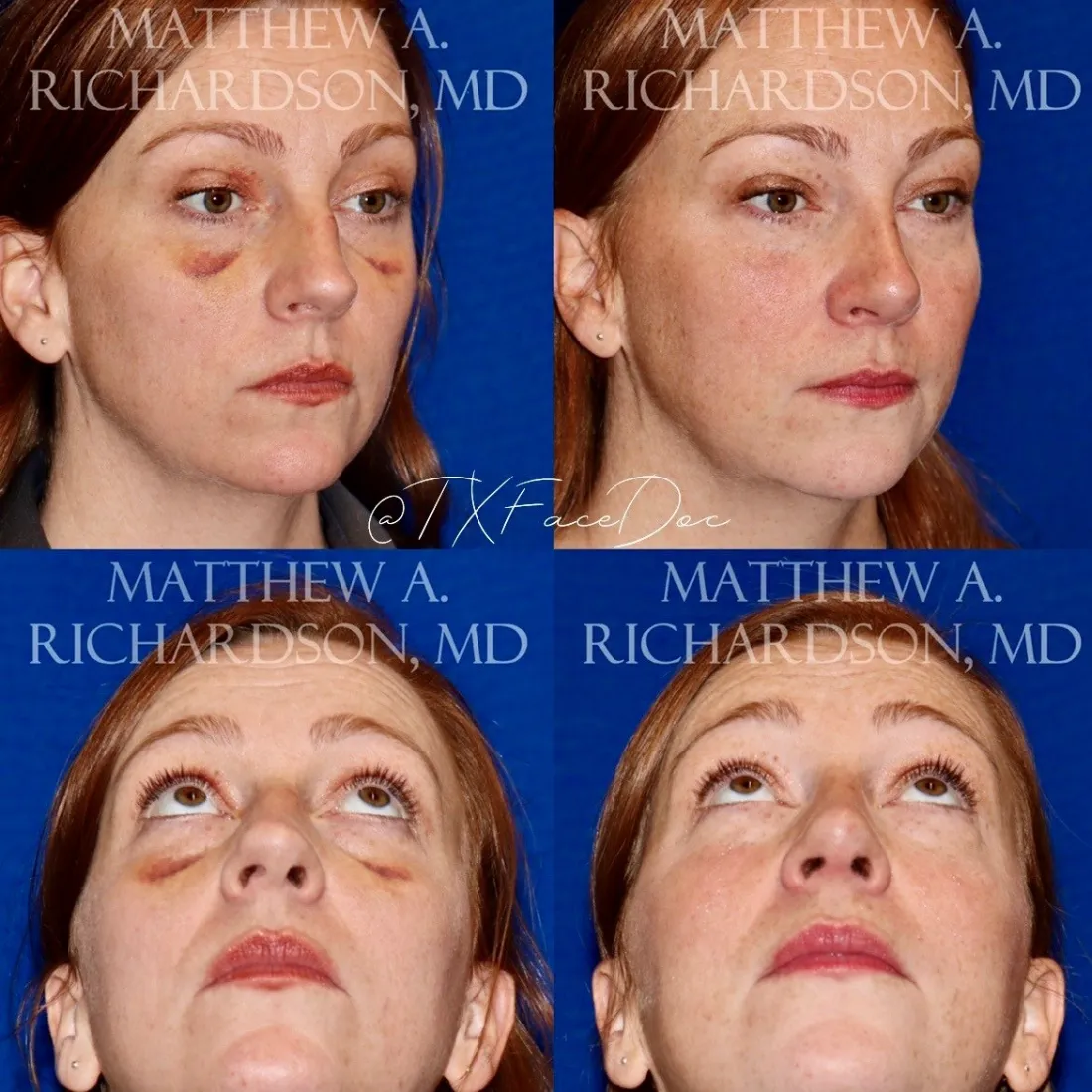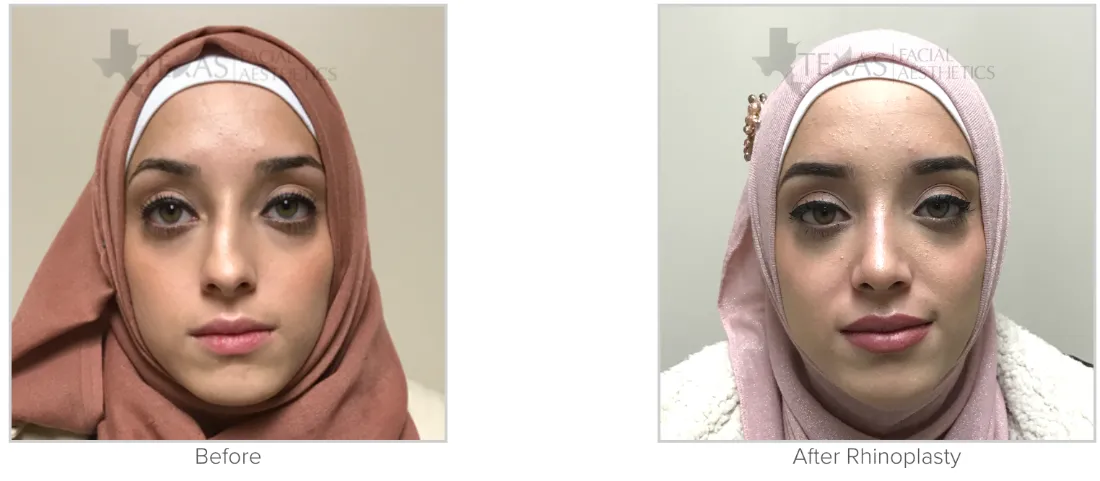Facial Trauma
Conveniently Located to Serve the Dallas, Fort Worth, Collin, and Denton Counties.
Conveniently Located to Serve the Dallas, Fort Worth, Collin, and Denton Counties.
Conveniently Located to Serve the Dallas, Fort Worth, Collin, and Denton Counties.



Facial Trauma Surgery by Experts
As Facial Plastic Surgeons, Dr. Richardson and Dr. Cain are expertly trained to repair facial injuries and facial trauma, including soft tissue injuries like lacerations, avulsions, and scars, and bony injuries like broken noses. We understand that a facial injury is a very frightening event, and our team can help you navigate this difficult time.
With extensive training in head and neck surgery and facial plastic surgery, their skills allow them to restore both form and function to any facial injury. In many cases, a patient’s health insurance will help defray the costs associated with treatment, but patients may be responsible for insurance copays and deductibles. In some cases, treatment may be considered cosmetic, but the doctors can help you sort out these issues and discuss your treatment options in detail during your consultation.

The types of injuries that we commonly treat include:
- Facial lacerations
- Lip or mouth lacerations
- Eyelid injuries
- Scalp lacerations
- Facial soft tissue injuries
- Nasal bone fractures (broken noses)
- Nasal septum fractures
- Orbital fractures (eye socket)
- Facial scars
- Ear lacerations or avulsions
- Auricular hematoma or seroma
- Facial nerve weakness or facial paralysis
Even if your injury has been repaired in an emergency room or urgent care center, if you have any concerns about scarring or other issues related to a facial injury, it is best that we see you within a few days after the initial injury in order to help ensure the best healing possible.
If you or your family member has an injury that needs repair after hours, you should call 911 or go to the nearest emergency center for treatment. For more information on some of these specific topics, read further below. This information is provided as general knowledge, not specific medical advice for any individual.
What is a nasal fracture? How do I know if I have a broken nose?
A nasal fracture is a broken bone within the nose. Generally, a nasal fracture is referring to a break, crush, or displacement of the nasal bones, which are the hard bones at the top of the nose between the eyes. If these bones are broken from an injury, patients will almost always have pain, tenderness, bruising, epistaxis (nosebleed), swelling, and mobility of the nasal bones. In some cases, the nose will be visibly displaced. A black eye (infraorbital bruising) may occur immediately or a few days later.
A trained physician can examine the nose and usually make a diagnosis of a nasal bone fracture clinically (by the exam and history). In some cases, imaging studies might be needed. Nasal bone x-rays are not usually very helpful. A facial CT scan is a much better study to look at the anatomy of the nasal bones.
What is a nasal septal fracture? What is a nasal septal hematoma?
The nasal septum divides the left and right sides of the nose internally, but also makes up a portion of the external appearance of the nose. The septum is critically important to nasal breathing, support, structure, and appearance. The nasal septum can be broken just like the nasal bones can be fractured. The septum is made up of both bone and cartilage, and either of these can be damaged by an injury. If the bone or cartilage is deviated enough from an injury to obstruct the airway, surgical correction might be required in order to restore nasal breathing.
A nasal septal hematoma is bleeding within the nasal septum that can occur from an injury or surgery. This bleeding expands to the point of causing a blood clot. Symptoms might include nasal pain, pressure, bleeding from the nose, and/or nasal obstruction. Nasal septal hematomas should be treated with surgical drainage in order to prevent necrosis (death) of the septal cartilage and possible delayed infection of the blood clot.
What is needed to fix a broken nose?
In many cases, a nasal fracture of the bones or septum might not require any medical or surgical treatment. The indications for repairing a nasal fracture include visible deformity (the nose is crooked or altered after injury), or nasal obstruction (inability to breathe through the nose because of anatomical injury). If the patient is able to breathe normally through the nose, and the nose looks visibly the same as prior to the injury, then there is no indication for surgical repair of a nasal fracture. The injured nasal bones will typically heal on their own over the course of 6 to 8 weeks.
If there is visible displacement of the nasal bones, a facial plastic surgeon like Dr. Richardson or Dr. Cain may be able to “set” the nasal bones through a procedure called a closed nasal reduction. In this procedure, the patient is given anesthesia (either sedation or general anesthesia), and the nasal bones are essentially pushed back into place. A cast is then placed on the nose for approximately one week. The key is that the nasal bones must be treated within 10-14 days to have the best chance of successful repositioning and reduction of the fracture. After about two weeks, the bones and soft tissues have already started to heal in place, and closed reduction has a lower chance of success.
Several weeks after an injury, if the nasal bones remain deviated, patients may require a rhinoplasty or septorhinoplasty surgery to achieve improvement in form (appearance) or function (nasal breathing). CLICK HERE to read more about rhinoplasty surgery, or CLICK HERE to read more about septoplasty surgery.
What is a facial laceration?
A facial laceration is a cut in the skin. Lacerations can be very superficial (shallow, close to the skin’s surface) or very deep (through multiple layers of skin and soft tissue). Some facial lacerations may extend down through the skin, fat, and muscle, even down to the bone. Some facial lacerations also involve other injuries such as nasal bone fractures as described above, other facial fractures, or soft tissue injury that causes necrosis (death) of the surrounding tissue.
How is a facial laceration repaired? What happens during laceration closure?
Facial lacerations can be repaired in many different ways. In some cases, facial lacerations might be closed with only steri-strips, tape, or glue. In our practice, we almost always close facial lacerations with sutures in order to achieve the best results with the utmost precision.
Generally, a facial laceration on an adult can be repaired with local anesthesia. In these cases, we first numb the area with local anesthesia (like lidocaine injections). The skin and wound are then thoroughly cleaned. This might involve antiseptics, antibiotics, or irrigations like saline, depending on the location, depth, and type of injury (clean, dirty, contaminated). Once the wound is fully anesthetized and cleaned, the wound is usually closed in layers using several different types of sutures. A protective dressing might be placed to cover the wound, or the sutures might be left open and dressed with antibiotic ointment.
How do I know if I need stitches? Does a facial laceration require sutures?
Every wound and injury is unique. Superficial facial lacerations might not require much more than steri-strip or glue closure, but most facial lacerations will heal best with suture closure in order to close the layers of the face and skin properly. This also allows us to approximate and align the skin edges very precisely. In most cases, skin sutures will be removed within 5-7 days for the best cosmetic outcome. Patients with a facial laceration should be seen by a physician who commonly treats facial lacerations and injuries in order to determine whether the laceration needs sutures.

Does a facial laceration need a facial plastic surgeon?
In emergency departments and urgent care centers, lacerations are often closed with large sutures, staples, or glue, without multiple layers of closure. Unfortunately, these techniques often result in less than optimal scars. These scars might be wide, depressed, or otherwise unsightly.
One key factor to remember is that any time a cut is made in the skin, whether the cut is made surgically or because of trauma, there will be a scar. The important thing is making the scar as minimal as possible. We want facial scars to be well-hidden, small, and with smooth texture. Facial laceration repair requires complex surgical closure techniques and the use of specialized sutures to achieve the best results. These skills, techniques, and equipment are an every day part of our practice, and make Dr. Richardson and Dr. Cain qualified to perform these types of laceration closure and repair.
Does a facial dog bite need to be closed? Should a bite wound be left open?
There is a common misconception that facial dog bites should be left open and not closed with sutures because a dog’s mouth (or even a human’s mouth!) is highly contaminated with bacteria, and closing that facial wound is highly likely to result in an infected wound. While an infection is always possible after a traumatic facial injury, we have found that bite wounds only rarely get infected when treated properly with wound debridement, irrigation, and antibiotics as indicated. Patients with a facial laceration that is left open will almost always develop a wide, ugly scar that will require scar revision at a later date. Patients with a facial laceration that is repaired (even a bite wound) will only rarely develop a wound infection that requires further intervention. For this reason, we always clean a bite wound and then close it surgically with sutures.
Can a facial scar be removed? How to remove a face scar?
A facial scar can usually not be fully removed, but can almost always be improved. Surgery, lasers, peels, and other resurfacing treatments might be needed to achieve the best results. CLICK HERE to learn more about scar revision options.
What is an auricular hematoma? What is an auricular seroma?
An auricular hematoma is a collection of blood under the skin of the ear. This blood collects between the skin and the cartilage of the ear. A seroma is a similar fluid collection, but rather than blood, the fluid that collects in the same space is a clear, watery fluid made by the patient’s body. While hematomas and seromas can occur spontaneously, they are most commonly caused by injury to the ear. These injuries might be from wrestling (most common), or another type of blow to the ear, such as punch, collision, ball strike, or other injury.
An auricular hematoma or seroma should be treated sooner rather than later, ideally within the first 24 hours after accumulation. These fluid collections are treated by surgical incision and drainage. In most cases, Dr. Richardson or Dr. Cain will numb the ear with an injection of local anesthetic like lidocaine, and then make a small incision in the skin to release the blood or fluid from the ear. The doctor will then try to close the wound so that more fluid will not collect between the skin and the cartilage of the ear. This can be performed in a variety of different ways depending on the patient’s anatomy. Sutures will then usually be removed about 7-10 days later, and patients should limit physical activity during that time in order to avoid further fluid collection or wound breakdown.
An untreated ear hematoma or auricular seroma will commonly lead to a deformity of the ear from the scar tissue that develops over time. This deformity is commonly referred to as a cauliflower ear. This type of ear deformity is often seen on wrestlers, boxers, and mixed martial artists who take blows to the ears as part of these sports.

*Individual Results may vary.
Real Patient Photo Gallery
View before-and-after pictures of real patients
How can I set up a Facial TRauma Repair Consultation?
Call or text Texas Facial Aesthetics at 469-362-6975 to set up a consultation with either Dr. Matthew Richardson or Dr. Jordan Cain. You can also email us at info@txfaces.com for more information.
